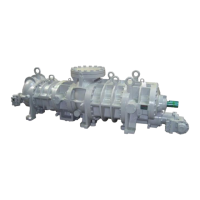2202MYJE-MY-C8-N_2018.02.
Chapter 5 Maintenance and Inspection
Compound 2-stage Screw Compressor 3225**C 5.5 Reassembly
5-65
■ Disassembly
Refer to Section 5.5.2.1 in this manual for the disassembly procedure for the potentiometers on the
low-stage and high-stage sides.
■ Inspection
a) In the normal condition where the hydraulic line for the capacity control of the compressor is not
opened, set the unloader piston to the no load and full load positions from the manual capacity
control circuit and check the operation of the control circuit to see if the micro-switch can detect the
0 % (30 %) and 100 % positions of the micro-switch cam (i.e., by checking the operation of the
relevant relays and contacts).
b) After shutting down the control power and carrying out the lock-out and tag-out procedures, remove
the indicator glass and check that the micro-switch mounting screws [126] are not loosened.
c) Check that the hexagon socket set screw [128] securing the micro-switch cam [127] are not
loosened.
d) After checking that the wiring for the micro-switch has been removed, turn on and off the switch to
check the normal switching operation of the micro-switch using a circuit tester.
e) If the hydraulic line for the capacity control of the compressor is opened for overhaul or other work,
use nitrogen gas or compressed air to set the unloader piston to the no-load and full load positions
and check if the micro-switch can detect the 0 % (30 %) and 100 % positions of the micro-switch
cam.
f) Carry out other visual inspection including any indication of water intrusion in the indicator, any rust
on switch terminals, any wear of the switch roller or micro-switch cam, and so on.
5.5.15.3 Reassembly
To carry out the reassembly, follow the disassembly procedure in reverse. Lastly, correctly set the
needle position according to the following procedure:
a) If the hydraulic line for the capacity control of the compressor is opened for the purpose of overhaul
or other work, use nitrogen gas or compressed air to set the unloader piston to the no-load position.
Then, set and fix the indicator dial needle to the origin of the figure to show the rotation on the dial.
Next, set the piston to the full load position. Make sure the indicator dial needle points to the end
point of the figure on the dial.
b) In the normal condition where the hydraulic line for the capacity control is not opened, use the
manual capacity control circuit to move the piston. While the control power is turned on, the
indicator cover must be mounted to prevent possible electric shock. Then, after the piston position is
fixed, control power is turned off, and the lock-out and tag-out procedures are completed, remove
the indicator cover and secure the indicator dial needle in position.

